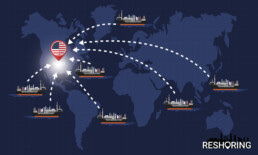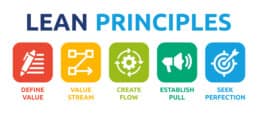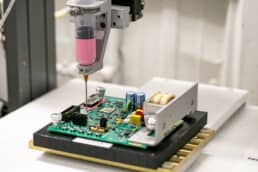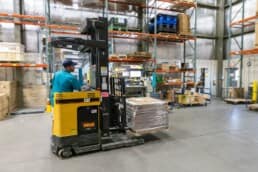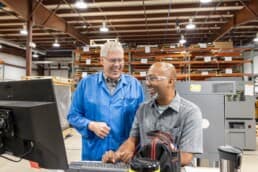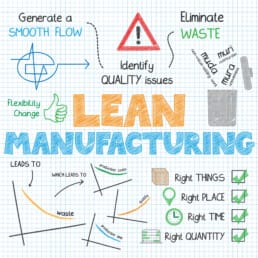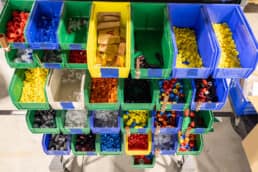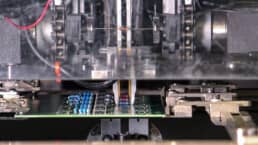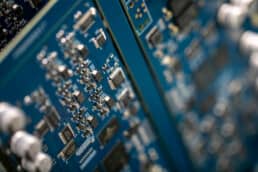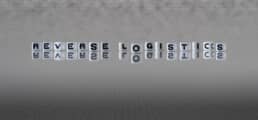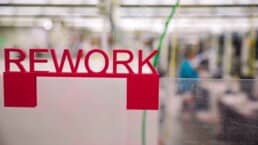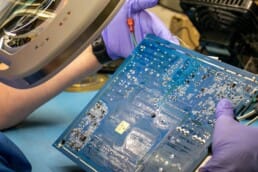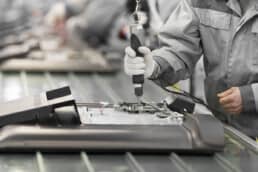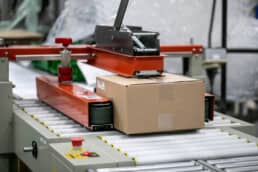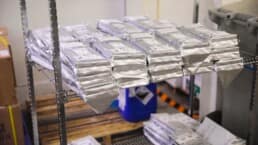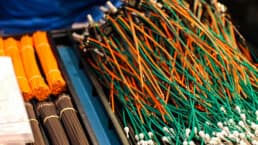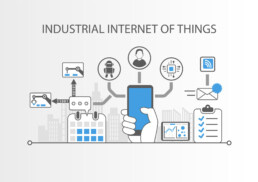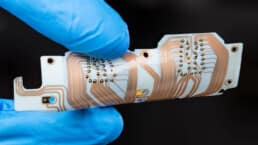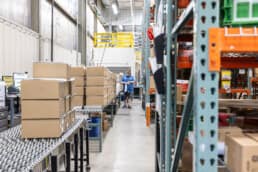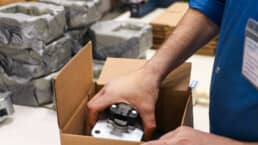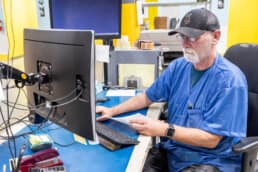Why Reshoring Manufacturing to the US Makes Sense
In today’s competitive environment, original equipment manufacturers (OEMs) seek to strengthen their supply chain while maintaining excellent quality. To achieve this, many companies are relocating manufacturing closer to home. This process is known as reshoring. Over the past several decades, many North American OEMs transitioned manufacturing offshore. These operations typically went to locations in Asia, such as China, to take advantage of perceived lower costs. Reshoring is the opposite of offshoring and simply brings manufacturing back overseas. While some costs may be lower with offshoring, many OEMs realized that reshoring is much more competitive. It becomes an attractive option when considering the total cost of ownership and brand reputation. On-going global trade tensions, geopolitical instabilities and COVID-19 have resulted in significant disruptions and strains on supply chains. OEMs seek more localized suppliers to address these uncertainties to create a more robust supply chain with fewer risks. Reshoring manufacturing to the US is an ideal solution. There are many advantages to partnering with a contract manufacturer and reshoring with US manufacturing. This article highlights the main benefits and recommends partnering with a proven contract manufacturer like RiverSide Integrated Solutions (RIS). We have three state-of-the-art manufacturing facilities in the US with distribution networks across the Americas. Note that all of the advantages below result in production efficiencies and cost savings. They also come with lower supply chain risk for OEMs. Offshore manufacturing is known for its less expensive labor. However, offshoring often involves raw materials, tools and equipment that are also cost-driven, often leading to quality issues. Many North American OEMs seek reduced quality risks and an alternative to offshore manufacturing. Reshoring with a US contract manufacturer offers North American OEMs more reliable and higher-quality products. This translates to a higher-value manufacturing solution with reduced risk. The US has strict standards and has earned a reputation for manufacturing very high-quality products for various industries. RIS, for example, is a contract manufacturer based in Minnesota and serves various high-quality products in markets worldwide. Location is the most apparent benefit of reshoring to the US, and it’s not one to take lightly. OEMs must maintain control over manufacturing, and it is much easier to oversee manufacturing when it is closer to home. As noted, RIS is in the midwest of the US. People can easily travel to most locations in North America in a few hours. In contrast, most flights to Asia take a day. Additionally, the time differences across North America are manageable, allowing similar work schedules between personnel and manufacturing locations. A considerable advantage to partnering with a US contract manufacturer compared to Asia with a 14-hour time difference. This becomes especially important when dealing with urgent matters that cannot afford a delay. Reshoring means that goods take only hours to arrive instead of weeks compared to Asian countries. As a result, transportation costs are much lower. There is also a lower risk of delays or damage during transit. Issues with the supply chain have only amplified these benefits in recent years. During 2020, significant travel and logistics delays with goods from Asia occurred. Shipping costs skyrocketed in 2020, specifically container freight rates, due to logistics disruptions caused by the pandemic. Reshoring with a US contract manufacturer streamlines logistics for OEMs. This reduces the risk of logistics delays and cost spikes. It also secures brand reliability and consumer trust. As with all supply chains, reducing the inventory throughout the chain is key. For example, goods transported by ocean freight often have a lead time of at least eight weeks. They spend six weeks of those weeks on the water in transit. This scenario results in two significant issues. Firstly, a defect would require the recall of all products in the supply chain, including the inventory on the water. Secondly, volume adjustments due to demand fluctuations are slow and lag by around eight weeks. A real-world example of these issues played out at ports across the globe. Due to logistics disruptions caused during the COVID-19 pandemic, ports observed massive pile-ups of container ships. These delays took months to resolve, resulting in enormous product delays. Reshoring with a US contract manufacturer solves the inventory on water problem by decreasing the time spent in transit. This improves speed to market and ability to rapidly respond to changing market conditions and customer demands. Over time, companies have continued to emphasize responsible and sustainable manufacturing. Factory conditions are of the utmost importance, as is the origin of raw materials. One advantage of partnering with a US contract manufacturer is the value it places on its workforce. US auditors enforce labor laws, and there are limits on how many hours personnel can work each week. There are also restrictions that ensure a safe work environment. Additionally, there are laws to ensure the quality and traceability of raw materials for manufactured products. Unfortunately, you cannot say the same about many countries in Asia. Companies doing business in the US know the workforce is cared for and their reputation is not at risk. Reshoring manufacturing to the US offers many benefits and makes good business sense. The team at RIS is well-positioned and ready to serve as America’s reshoring partner. We employ more than 350 people and provide a myriad of manufacturing services to OEMs across the world. Contact our team today to learn more about our range of contract manufacturing solutions.
THE BENEFITS OF RESHORING MANUFACTURING
SUPERIOR QUALITY
EXCELLENT PROXIMITY TO THE US AND CANADA
STREAMLINED LOGISTICS
LESS INVENTORY ON WATER
RESPONSIBLE BUSINESS
About RiverSide Integrated Solutions
RIS is an advanced contract manufacturer providing robust solutions in circuit board assembly and product assembly. We employ more than 350 people and provide services to OEMs worldwide. We operate two state-of-the-art manufacturing facilities within the US.
With all of the choices in contract manufacturers out there, we know it can be challenging to find someone who understands your business model and has your best intentions in mind. RIS has always proven to be a win-win-focused relationship.
As your one-stop shop, we have the capabilities, capacity, quality assurance standards and resources to support all of your manufacturing needs. We understand that supply chain management is complex and very time-consuming, so we urge our customers to utilize us in the fullest capacity.
Our total-package solutions include:
- Extensive supply-chain network
- Full box-build assembly
- Dedicated Program Team
- Warehousing, kitting and drop-shipping capabilities
- Reverse logistics
- Flexible order fulfillment
- Scalability to meet your needs
Contact us today at (507) 523-3220 to see how we can help with your manufacturing project, or click contact us for a quote.
Lean Manufacturing Principles
Many original equipment manufacturers (OEMs) have adopted lean manufacturing as a keystone for success in today’s market. A lean manufacturing approach offers companies an array of benefits. When lean principles are applied, sources of waste are reduced or even eliminated. This improves operations efficiency and product quality – adding significant value for customers. With shorter production times, manufacturers are more nimble and able to respond to customer needs and market conditions. Additionally, lean strategies can be applied to supply chain and product development processes. This leads to quicker speed to market and a significant competitive advantage. Whether OEMs perform production in-house or outsource to a contract manufacturer, they need to understand lean principles. At RiverSide Integrated Solutions (RIS), we utilize lean principles to our teams a competitive edge. Lean principles focus on streamlining production to improve value and productivity while minimizing waste. From a lean perspective, waste is anything that does not add value. Below are the five fundamental principles of lean manufacturing. Lean manufacturing can significantly enhance efficiencies and productivity gains that lower production costs. That’s why it’s so important that contract manufacturers effectively implement these concepts. Lean provides the advantage companies seek. Manufacturers from every sector have successfully applied these principles. This lean manufacturing principle takes as its base the way customers define “value.” The value points for lean need to be clearly defined and communicated. It’s nearly impossible for contract manufacturers to streamline the manufacturing process if they aren’t. Value requires designing and manufacturing products that meet customers’ needs and remove unnecessary features or “extras”. Design for manufacturability (DFM) is a process often used to identify and eliminate waste in design and production. DFM is designing a product for easy manufacturing and creating a better, more cost-effective product. It is a vital product-development step that simplifies and optimizes the design. This ensures high quality and efficiency during production and integrity once in the field. DFM aims to reduce manufacturing costs and avoid costly disruptions without sacrificing quality or performance. Visit our website for additional tips on incorporating DFM into lean manufacturing. This step involves mapping out the processes contributing to the value stream from beginning to end. It often starts with raw material acquisition and ends when the customer receives the final product. Once you’ve mapped your value stream, it is easier to identify and address steps that do not add value. This is a critical aspect of lean manufacturing. The purpose is to identify potential waste areas and work to reduce or eliminate the waste. Identification and elimination of waste are crucial to the success of lean manufacturing. Contract manufacturers often identify several types of waste when they apply a lean approach. Below are some of the most common approaches. This applies to personnel or machinery. When workers spend time waiting for machines to be available or materials to arrive, there is room for improvement. Too much or too little inventory leads to inefficiencies and waste. Logistics includes the workflow of the product on the manufacturing floor. Still, it extends beyond the facility to acquire raw materials and transport the final product to the customer. The objective of manufacturing is to meet specifications per the agreed-upon design. There is often a significant amount of wasted time, equipment and resources spent on over-engineering and over-processing a product. This can be wasted motion of personnel or equipment. Reducing unnecessary movement is key to improving the entire manufacturing supply chain. Facilities that are organized and laid out well excel in this area. Quality teams need to spend time building their quality control processes into production properly. If they don’t, scrapping and reworking off-spec products can be a massive area of waste. Once teams have streamlined processes to remove waste, operations should run more smoothly and efficiently. This improves product flow. Efficient product flow requires items to move with minimal delays or interruptions. It looks at all the steps of the manufacturing process. This includes procurement to production to secondary operations to packaging to customer delivery with minimal delays or interruptions. Contract manufacturers that apply lean manufacturing principles should follow raw materials throughout the manufacturing process. This will help them better understand areas for improvement. It will also help them optimize the facility layout, materials handling and personnel touch points for success. A well-organized manufacturing facility achieves efficient product flow, reducing production times and inventory requirements. With the process running more smoothly, contract manufacturers can use a pull-based production system – another principle of lean manufacturing. Products can be manufactured and delivered “just in time,” reducing inventory requirements and costs. This also results in a shorter time to market, further driving competitiveness. The key to pulling systems is to have the right materials in the right quantity at the right time. This is very similar to Just-in-Time (JIT) manufacturing. In short, it’s about producing only the required volume at the right time. With JIT, order placement triggers the manufacturing process for products. This type of manufacturer keeps raw material and final product levels low. This reduces waste on surplus inventory and avoids overproduction. Comparatively, with traditional push manufacturing systems, a supply purchase triggers the process. This then pushes material through the process even when an order may not exist. These push systems are easier to create. However, they often result in more extensive inventories and other waste. The final principle is to seek perfection. This concept is about continuous improvement. Lean manufacturing is an ongoing assessment to avoid waste and inefficiencies from creeping back into the process. This principle often seems easy but is very difficult to implement. It requires contract manufacturers to be diligent continuously – not just for a fixed period. One way to seek perfection is with the company culture. Companies with a lean culture ensure that all personnel are empowered to participate in continuous improvement efforts. All levels of the organization must participate in the lean culture, from management to the production floor. At RIS, a key focus of our lean manufacturing approach is maximizing customer value while minimizing waste. We empower every employee to make a difference by coming forward with suggested improvements.The 5 Key Principles of Lean Manufacturing
1. DEFINE VALUE
2. VALUE STREAM
WAITING
UNOPTIMIZED INVENTORY
INEFFICIENT LOGISTICS
OVER-PROCESSING OR OVER-ENGINEERING
UNNECESSARY MOTION
DEFECTS OR OTHER QUALITY ISSUES
3. CREATE FLOW
4. ESTABLISH PULL
5. SEEK PERFECTION
About RiverSide Integrated Solutions
RIS is an advanced contract manufacturer providing robust solutions in circuit board assembly and product assembly. We employ more than 350 people and provide services to OEMs worldwide. We operate two state-of-the-art manufacturing facilities within the US.
With all of the choices in contract manufacturers out there, we know it can be challenging to find someone who understands your business model and has your best intentions in mind. RIS has always proven to be a win-win-focused relationship.
As your one-stop shop, we have the capabilities, capacity, quality assurance standards and resources to support all of your manufacturing needs. We understand that supply chain management is complex and very time-consuming, so we urge our customers to utilize us in the fullest capacity.
Our total-package solutions include:
- Extensive supply-chain network
- Full box-build assembly
- Dedicated Program Team
- Warehousing, kitting and drop-shipping capabilities
- Reverse logistics
- Flexible order fulfillment
- Scalability to meet your needs
Contact us today at (507) 523-3220 to see how we can help with your manufacturing project, or click contact us for a quote.
Why the Capabilities of Your Contract Manufacturer Matter
Optimization of the supply chain is a challenge for every company. A company’s supply chain starts with raw material acquisition and ends when the customer receives the final product. It comprises all suppliers that participate in the sourcing, production, subassembly, final assembly, fulfillment, distribution and other processes required to create the final product. When it comes to outsourcing the various supply chain steps, original equipment manufacturers (OEMs) must decide whether to partner with several suppliers or a single source provider. When making this decision, OEMs must consider the breadth and depth of capabilities of any potential contract manufacturer. Simply put, the capabilities of your contract manufacturer matter immensely.Why Does My Contract Manufacturer’s Capabilities Matter?
RiverSide Integrated Solutions (RIS) is an integrated contract manufacturer, which means we perform multiple steps along the supply chain, including manufacturing and/or assembly, as well as value-added operations such as supply chain management, kitting, distribution and fulfillment.
Integrated contract manufacturers, like us, offer significant value for OEMs, such as streamlining the manufacturing timeline, improving the consistency and reliability of the final part and minimizing the number of suppliers involved in the supply chain. All of these steps improve efficiency and reduce risk. This saves OEMs time, resources and money.

The capabilities of your contract manufacturer matter, as not all manufacturing companies can offer integration that includes supply chain management, kitting, distribution and fulfillment. These steps often require specific equipment, facilities and processes as well as personnel with the right skills and expertise to result in a high-quality, cost-effective manufacturing solution.
It is crucial that OEMs partner with a manufacturer that has the proven experience, facilities and know-how to safely and successfully perform integrated projects. Below are some benefits of partnering with an integrated contract manufacturer like RIS, which offers a complete manufacturing solution to strengthen customers’ supply chains.
Benefits of Working with an Integrated Contract Manufacturer
As markets become increasingly competitive, integration becomes more of a necessity. By minimizing the number of suppliers involved in the various stages of the supply chain, companies increase control, leading to lower risks, higher efficiency and lower costs. All of these things provide a better competitive edge for the company.
Below are some of the advantages of an integrated business model and why the capabilities of your contract manufacturer matter.
Fewer Disruptions

Integrated contract manufacturers maintain control of the product and have fewer “hand-offs” and transition points across suppliers. When suppliers control more than one stage of the supply chain, they experience fewer disruptions and delays. As a result, the supply chain process flows more smoothly, and products get to customers more rapidly, which reduces time to market.
Additionally, integrated teams have fewer surprises and can more effectively manage problems.
Growth Opportunities
Not all contract manufacturers offer the same solutions, and what you need
today may not be what you need tomorrow. Manufacturers with broad capabilities and offerings are better positioned to provide support as your business evolves and grows.
For example, the team at RIS has nearly 40 years of experience in Materials Management, from supplier qualification through procurement and full-service inventory management. With our strong relationships with component manufacturers and distributors, we provide complete materials planning, purchasing and warehousing to maximize customer savings and minimize customer liability. As a result, our customers take advantage of the vast purchasing experience and volume purchasing that results from years in the manufacturing business. For our customers, this means more sourcing options, leverage to ensure reliable delivery and lower cost for assembly components.
These are just a few examples of the growth opportunities available when you partner with a contract manufacturer, like RIS, that offers a broad range of capabilities.
Leverage Expertise
Most OEMs must outsource most or all of the supply chain as they need the in-house equipment and skill sets required to complete production, kitting, assembly and other necessary supply chain steps. Integrated manufacturers have the necessary tools and skilled workforce to complete these steps, including complex electronics and product assemblies, frequently at a higher level of quality than the OEM.
At RIS, we encourage our customers to leverage our expertise. We possess deep and broad levels of experience across various industries and can offer suggestions to improve your manufacturing project.
Improved Quality and Customer Satisfaction
The integration allows contract manufacturers to track and control quality even more closely as a product progresses along the supply chain. This results in fewer off-spec products and a better overall customer experience.
This integration enables manufacturers to be nimbler and more responsive to changing market conditions and customer demands. Instead of relying on other suppliers, integrated manufacturers directly influence the customer experience throughout the supply chain. By controlling their destiny, integrated facilities often have happier customers.
Reduce the Number of Providers
OEMs typically have multiple vendors involved in their supply chain – yet too many suppliers result in inefficiencies. Therefore, generally speaking, it is advantageous to minimize the number of providers along the supply chain.
OEMs receive a complete manufacturing solution when partnering with a provider like RIS that offers a diverse spectrum of manufacturing capabilities. Reducing the number of providers adds value by improving communications and accelerating speed-to-market, as well as cutting manufacturing and post-operations costs.
At RIS, because of our broad range of capabilities, we can guide customers

through the entire supply chain smoothly and quickly – resulting in a more seamless manufacturing process.
Incorporate Secondary Operations
Many OEMs with efficient supply chains have combined production with secondary operations like kitting, assembly and fulfillment. However, your contract manufacturer must offer more than just production. Outsourcing secondary functions to your contract manufacturer saves time and money as the products do not have to be transported or stored between production and post-production steps.
In addition, companies often secure better contract rates when a single manufacturer provides more services.
About RiverSide Integrated Solutions
RIS is an advanced contract manufacturer providing robust solutions in circuit board assembly and product assembly. We employ more than 350 people and provide services to OEMs worldwide. We operate two state-of-the-art manufacturing facilities within the US.
With all of the choices in contract manufacturers out there, we know it can be challenging to find someone who understands your business model and has your best intentions in mind. RIS has always proven to be a win-win-focused relationship.
As your one-stop shop, we have the capabilities, capacity, quality assurance standards and resources to support all of your manufacturing needs. We understand that supply chain management is complex and very time-consuming, so we urge our customers to utilize us in the fullest capacity.
Our total-package solutions include:
- Extensive supply-chain network
- Full box-build assembly
- Dedicated Program Team
- Warehousing, kitting and drop-shipping capabilities
- Reverse logistics
- Flexible order fulfillment
- Scalability to meet your needs
Contact us today at (507) 523-3220 to see how we can help with your manufacturing project, or click contact us for a quote.
Benefits of Lean Manufacturing
Lean manufacturing (lean) has been around for decades. It focuses on streamlining production to improve value and productivity while minimizing waste. From a lean perspective, waste is anything that does not add value. It is important to understand lean concepts and how they can give your team a competitive edge. This is true whether original equipment manufacturers (OEMs) perform production in-house or outsource to a contract manufacturer. At RiverSide Integrated Solutions (RIS), we use lean principles at every level and stage of production. This helps us ensure we provide only the highest quality services to our customers. Lean manufacturing offers an array of benefits. When lean principles are applied, sources of waste are reduced or even eliminated. This improves operations efficiency and product quality – adding significant value for customers. With shorter production times, manufacturers are more nimble and able to respond to customer needs and market conditions. Additionally, lean strategies can be applied to supply chain and product development processes. This leads to quicker speed to market and a significant competitive edge. Improved efficiency makes personnel and equipment available for innovations. As they streamline their processes, OEMs can better respond to fluctuations in demand and other market variables. This ultimately results in fewer delays and better lead times. Less waste and better adaptability make OEMs better positioned to thrive today – and tomorrow. More productivity, less waste, and better quality make a more profitable company. Identification and elimination of waste are crucial to the success of lean manufacturing. Your quality improvement team may flag several types of waste when using a lean approach in manufacturing. This includes contract manufacturers. Below are some of the most common forms of waste identified: This applies to personnel or machinery. When personnel spend time waiting for machines to be available or materials to arrive, the facility’s efficiency suffers. Too much or too little inventory leads to inefficiencies. Logistics includes the workflow of the product on the manufacturing floor. Still, it extends beyond the facility to include acquiring raw materials and transporting the final product to the customer. The objective of manufacturing is to meet specifications per the agreed-upon design. There is often a significant amount of wasted time, equipment and resources spent on over-engineering and over-processing a product. This can refer to wasted motion of personnel or equipment. Reducing unnecessary movement is key to improving the entire manufacturing supply chain. Facilities that are organized and laid out well excel in this area. Scrapped products and rework of off-spec products can be a huge area of waste. Quality teams must take the time necessary to develop their quality control processes. If they don’t, it can lead to waste increase. Let us now discuss some practical ways to apply lean principles to manufacturing. When lean principles are applied, sources of waste are reduced or even eliminated. This improves operations efficiency and product quality – adding significant value for customers. With shorter production times, machine shops are more nimble and able to respond to customer needs and market conditions. Additionally, lean strategies can be applied to the entire supply chain. They lead to quicker speed to market and a significant competitive edge. Each contract manufacturer’s culture permeates every aspect of the facility, including the manufacturing process. All levels of the organization must participate in the lean culture, from management to the production floor. It is essential to explain to personnel why a lean approach and efficient manufacturing are critical to business success. Personnel need to know that leadership is open to new ideas. They need to believe that the company will carefully consider any suggestions for improvements they submit. At RIS, a key focus of our lean manufacturing approach is maximizing customer value while minimizing waste. We empower every employee to make a difference. The physical layout of a manufacturing facility and the workflow path a product takes directly impact productivity. Namely the level of unnecessary motion impact this. Contract manufacturers that apply lean manufacturing principles should follow raw materials throughout the manufacturing process. This can help them better understand areas for improvement. Simple measures like the location of equipment can significantly impact manufacturing efficiency. Contract manufacturers are increasingly aware of the downtimes and costs resulting from unexpected equipment failures. They are implementing preventative and predictive maintenance plans to secure a competitive edge. Maintenance programs that rely on manual data entry and tracking are slow and are often too “reactive” in nature. It is vital to integrate smart, condition-based monitoring systems into existing manufacturing processes. These smart programs provide contract manufacturers with scheduled maintenance events based on known wear. They use observed conditions, dashboard monitoring and trends to create projections. To achieve lean manufacturing, the bottom line is to be proactive rather than reactive.What are the Key Strategies of Lean Manufacturing?
INCREASED QUALITY
FASTER SPEED TO MARKET
SUSTAINABILITY
IMPROVED BOTTOM LINE
TYPE OF WASTE COMMON IN MANUFACTURING
WAITING
UNOPTIMIZED INVENTORY
INEFFICIENT LOGISTICS
OVER-PROCESSING OR OVER-ENGINEERING
UNNECESSARY MOTION
DEFECTS OR OTHER QUALITY ISSUES
Examples of How Contract Manufacturers Apply Lean Principles
ESTABLISH A LEAN CULTURE
ORGANIZE THE FACILITY FOR SUCCESS
OPTIMIZED MAINTENANCE PLAN
About RiverSide Integrated Solutions
RIS is an advanced contract manufacturer providing robust solutions in circuit board assembly and product assembly. We employ more than 350 people and provide services to OEMs worldwide. We operate two state-of-the-art manufacturing facilities within the US.
With all of the choices in contract manufacturers out there, we know it can be challenging to find someone who understands your business model and has your best intentions in mind. RIS has always proven to be a win-win-focused relationship.
As your one-stop shop, we have the capabilities, capacity, quality assurance standards and resources to support all of your manufacturing needs. We understand that supply chain management is complex and very time-consuming, so we urge our customers to utilize us in the fullest capacity.
Our total-package solutions include:
- Extensive supply-chain network
- Full box-build assembly
- Dedicated Program Team
- Warehousing, kitting and drop-shipping capabilities
- Reverse logistics
- Flexible order fulfillment
- Scalability to meet your needs
Contact us today at (507) 523-3220 to see how we can help with your manufacturing project, or click contact us for a quote.
PCB Assembly: Surface Mount Technology
Printed circuit boards (PCBs) continue to grow in complexity. Because of that, PCB assembly has become an even more critical to electronics manufacturing. Even the slightest assembly error could lead to poor performance or failure. That’s why surface mount technology (SMT) has become a cornerstone of modern electronics manufacturing. Because it’s highly automated and precise, SMT enables more reliable assemblies at a reduced weight, volume and cost. This makes it an excellent choice for most electronics assembly, especially high-volume production. It is a great option for electronics needing a high density of components or requiring a smaller, lighter board. Given the criticality of this step, many original equipment manufacturers (OEMs) look to outsource. It is imperative that they partner with a knowledgeable contract manufacturer like RiverSide Integrated Solutions (RIS). At RIS, we have the requisite experience and proven processes to guide OEMs through the PCBA process. We can help you select the right assembly technologies to ensure success in the field. Before diving deeper into SMT, it will be helpful to better understand where it fits in the PCBA process. Below are the primary steps in the PCB assembly process. The steps and sequencing may vary slightly depending on whether SMT or through-hole technology (THT) are employed. Some may even employ both! However, the following describes the key elements of any PCBA process. The first step in PCBA is to apply the solder paste. It is applied to the sections of the PCB where components will be mounted. The paste is a mixture of solder and flux used to join the parts to the board permanently. The next phase is to place the necessary components on top of the solder paste. This step is often called “pick and place.” There are many different types of components for PCB, depending on functionality. Some of the most common are resistors, capacitors, inductors or sensors. This step’s purpose is to bond the components to the PCB permanently. SMT typically utilizes a reflow oven and conveyor system to melt the existing solder paste. Selective soldering machines are also becoming more popular. They are capable of precisely soldering boards with smaller and more complex layouts. With THT, the components have leads that go through existing holes on the board. A wave soldering method is the most common way to solder these boards. A wave solder machine uses a wave of molten solder that flows across the bottom of the board. In both cases, the molten solder joins the components and leads to the board. The assembly is then cooled to solidify the solder again and fix the parts. This phase of the PCBA process is crucial. Proper inspection is necessary to ensure production staff and machines performed prior steps effectively. This step may entail both manual and automatic inspections. The final step in the PCBA process is testing to ensure the PCB functions as designed. There are various test methods, such as flying probes, in-circuit testing, and others. The PCBA process is complete once testing is done. As noted, SMT is a widely utilized soldering method for PCBA. As the name implies, SMT attaches components directly to the surface of the PCB. It does so using tiny amounts of solder paste and does not require any holes in the board. In an SMT PCBA, the solder joint forms the physical and mechanical connections. Electronics made via SMT are called surface mount devices. SMT allows components to be mounted to both sides of the board. This allows for more components on a given board and smaller PCBs compared to one using THT. SMT often involves automated equipment that position and mount the components on the board. For more details about SMT at RIS, watch our short video. There are many advantages to using SMT during PCB assembly. Below are some of the key benefits. SMT components’ geometric size and volume are typically less than THT components. For this reason, SMT can fit a larger number of components on a PCB surface. This enables designers to create boards with high component density. Electronics continue to shrink in size, while the demand for more functionality increases. This means that SMT capabilities are only becoming an even larger advantage. With SMT, manufacturers can create higher- density PCBs. Elements of SMT are often automated, which enables rapid and precise mounting of the components on the board. This leads to efficiency gains that allow for higher production volumes while maintaining excellent reliability. Higher throughput of PCBs also results in lower board costs – another big advantage of SMT. SMT can utilize smaller and lighter components compared to THT. This enables SMT to create compact PCBs that maximize the space on the board without sacrificing functionality and performance. Lighter-weight PCBs are an important advantage of SMT for industries where weight is critical, such as aviation. THT assembly method requires component leads be bent into shape and inserted into holes drilled in the PCB solder joints. Conversely, SMT mounts components to the board without much drilling. This leads to a much simpler and faster PCB assembly process. Additionally, SMT does not require lead forming since leads are surface mounted to the pads. For these reasons, SMT makes PCBA much faster and less prone to error than THT. Surface-mounted components are often more reliable than through-hole components. In particular, SMT components are less prone to failure due to vibration, shaking and shock. SMT and THT components can co-exist on a single board. This enables designers to create electronics that employ both methods during PCB assembly. This may be necessary for designs where space constraints require using both connectors. At RIS, PCB assembly is one of our core competencies. We provide reliable, seamlessly-assembled printed circuit board systems built with extreme precision. Our skilled engineers, technicians and assemblers work to expertly put together a complete PCBA. When you choose RIS, you can expect the hands-on customer care of a small operation with the capabilities characteristic of a larger company. We provide our complete electronics manufacturing services for OEMs in any industry. Our electronics assembly expertise includes:Main Steps in the PCBA Process
1. APPLY SOLDER PASTE
2. PLACE THE COMPONENTS
3. SOLDERING
4. INSPECT THE ASSEMBLY
5. TESTING
What Exactly is Surface Mount Technology?
Advantages of SMT
INCREASED COMPONENT DENSITY
INCREASED EFFICIENCY AND THROUGHPUT
SMALLER, LIGHTER WEIGHT PCBS
SIMPLER PCBA
SUPERB RELIABILITY
MIXED TECHNOLOGY BOARDS
RIS PCBA EXPERTISE
About RiverSide Integrated Solutions
RIS is an advanced contract manufacturer providing robust solutions in circuit board assembly and product assembly. We employ more than 350 people and provide services to OEMs worldwide. We operate two state-of-the-art manufacturing facilities within the US.
With all of the choices in contract manufacturers out there, we know it can be challenging to find someone who understands your business model and has your best intentions in mind. RIS has always proven to be a win-win-focused relationship.
As your one-stop shop, we have the capabilities, capacity, quality assurance standards and resources to support all of your manufacturing needs. We understand that supply chain management is complex and very time-consuming, so we urge our customers to utilize us in the fullest capacity.
Our total-package solutions include:
- Extensive supply-chain network
- Full box-build assembly
- Dedicated Program Team
- Warehousing, kitting and drop-shipping capabilities
- Reverse logistics
- Flexible order fulfillment
- Scalability to meet your needs
Contact us today at (507) 523-3220 to see how we can help with your manufacturing project, or click contact us for a quote.
The Value in Strong Reverse Logistics
Many companies only judge their success based on delivering products to customers. But, there’s an important aspect they often overlook: what happens when a product is returned? Handling products returned to the original equipment manufacturer (OEM) is referred to as reverse logistics. When a customer returns something, the OEM is responsible for several things. First, they need to figure out how to ship it back to their warehouse. Then they need to decide if they can fix it or salvage parts. All of these things fall under reverse logistics. It takes a lot of time and money for OEMs to handle reverse logistics. That’s why so many hire other companies, called contract manufacturers, to do it for them. RiverSide Integrated Solutions (RIS) is a contract manufacturer that offers full-service solutions for our customers, including reverse logistics. Reverse logistics has become even more important in recent years because more people are shopping online. This means there are more returns to deal with. Companies must recognize reverse logistics because it affects many aspects of the business. It impacts reputation and profits and can cause other problems if not handled well. But, if companies can improve the process, they recieve many benefits. They can save money, make their customers happier and be more environmentally friendly. This can help them stand out from other companies. Plus, having an excellent reverse logistics strategy is more valuable than just thinking of it as a cost. Companies focus on reverse logistics because it can save them money. Keeping inventory is expensive, so manufacturers want to make the most of what they have. By making returns, repairs and replacements faster, companies can reduce how much inventory they need and save money. A strong reverse logistics system also means that companies can use their products longer. This means they can get more value out of what they make. And finally, reverse logistics can also help companies save money on transportation, shipping and customer service costs. Customers are more likely to come back if they have a good experience. If they don’t like a product, it’s important to fix the problem quickly. This can make a big difference in how they see your brand. More and more people are shopping online, and they want it to be easy to return things. If you make it easy for them, it shows that you care about them. Making sure returns go smoothly can mean the difference between a one-time customer and someone who returns repeatedly. This affects how much money you make. So it’s vital to have a good returns process that keeps customers happy. Have you ever thought about what happens to all the products that get thrown away? Companies need to do their part in being environmentally friendly. One option is to implement sustainable supply chain programs. Designing a robust reverse logistics program can make a big difference. It does so by reimagining how we handle returned or no-longer-needed products. Instead of just throwing them away, we can find ways to reuse, sell, or recycle them. This not only helps the environment, but it also makes our company look good. It’s essential to monitor returns in the supply chain, just like any other part of the process. Manufacturers need to do more than just deal with returns. They need to figure out why certain products are returned. Once they do this, they can reduce how often that happens. In the end, this will help the business run more smoothly. Once this has been sorted, it’s easier to see what’s happening across the entire supply chain. This means you can track how things are going from start to finish. Then you can look at how to improve processes. It’s easier to manage your supply chain if you see what’s happening. Manufacturers must ensure they meet their customers’ needs and can get value back from returned products. That’s why it’s important to have strict procedures for handling returns, warranties and any repairs or refurbishments. But many companies don’t have the people or resources to do this themselves. Instead, they turn to contract manufacturers like RIS to help. This allows them to return the value of their products. It also frees them up to focus on things like making better products and keeping their customers happy. At RIS, we have a team of experts who can help with all kinds of repairs. We do refurbishments, product testing, warranty claims and parts replacement. Our experienced team can help with all kinds of products. We specialize in electronics, mechanical parts and even systems that use water or other fluids.MORE THAN JUST A COST
DECREASED COSTS AND INCREASED ASSET UTILIZATION
GREATER CUSTOMER SATISFACTION AND HIGHER RETENTION
LESS ENVIRONMENTAL IMPACT
SUPPLY CHAIN TRANSPARENCY
REVERSE LOGISTICS AT RIS
About RiverSide Integrated Solutions
RIS is an advanced contract manufacturer providing robust solutions in circuit board assembly and product assembly. We employ more than 350 people and provide services to OEMs worldwide. We operate two state-of-the-art manufacturing facilities within the US.
With all of the choices in contract manufacturers out there, we know it can be challenging to find someone who understands your business model and has your best intentions in mind. RIS has always proven to be a win-win-focused relationship.
As your one-stop shop, we have the capabilities, capacity, quality assurance standards and resources to support all of your manufacturing needs. We understand that supply chain management is complex and very time-consuming, so we urge our customers to utilize us in the fullest capacity.
Our total-package solutions include:
- Extensive supply-chain network
- Full box-build assembly
- Dedicated Program Team
- Warehousing, kitting and drop-shipping capabilities
- Reverse logistics
- Flexible order fulfillment
- Scalability to meet your needs
Contact us today at (507) 523-3220 to see how we can help with your manufacturing project, or click contact us for a quote.
Why OEMs Outsource Kitting
Kitting is collecting and organizing separate but related parts for future use in manufacturing a product. Kits may be stored until needed on the manufacturing assembly line or delivered directly to customers. Putting items together into a kit sounds simple. Still, when you have thousands of parts and orders, it can be challenging to do effectively and efficiently. At some point, every original equipment manufacturer (OEM) must decide what core competencies it wishes to retain in-house. Outsourcing frees OEMs to focus on these core competencies, which often do not include kitting. For this reason, many companies outsource these responsibilities to a contract manufacturer. Kitting must occur where the product inventory resides. This creates an excellent opportunity for OEMs to outsource multiple parts of their manufacturing process simultaneously. That’s why so many OEMs partner with Riverside Integrated Solutions (RIS). As an integrated contract manufacturer, we can handle manufacturing, kitting, warehousing and many other services. This makes even more sense for OEMs that already outsource manufacturing to a contract manufacturer. Pushing kitting to them is a natural next step since kitting is the immediate upstream operation from the assembly. Even if an OEM decides to keep production in-house, outsourcing has significant advantages. Many of the upstream logistics processes can be outsourced. This includes procurement, inventory management, warehousing, picking, packaging of the kits, and shipping to a required destination. Our complete start-to-finish manufacturing support is a key advantage of choosing RIS as your contract manufacturing. We do everything from procuring materials to assembly and kitting to the final shipment. With RIS, you can access our comprehensive distribution capabilities that will expand your reach into any channel. Kitting services help OEMs save time and money and avoid the headaches that come with these operations. Let us figure out how to track inventory. Let us decide where to store products, how to package and distribute them. If you currently perform kitting in-house and are considering outsourcing, look at why OEMs outsource kitting: Kitting can be very time-consuming and pricey as there are many in-house costs. These include personnel, warehouse and storage facilities, IT management systems, and equipment. Cost reductions are one of the key reasons why OEMs outsource kitting. Contract manufacturers have the facilities, resources and processes that enable the completion of kitting operations more efficiently. The result is significantly lower costs and a competitive advantage for OEMs. Kitting improves productivity. Assemblers utilize pre-prepared kits when needed instead of picking parts from storage when something is ordered. This further reduces labor costs and saves time on the production line. Outsourcing to a contract manufacturer adds further kitting efficiency gains. Contract manufacturers, like RIS, can often perform kitting services faster. We have all of the necessary equipment and procedures for successful kitting already in place. The result of this is increased overall speed to market for our customers. Kit assembly and storage of assembled kits consume a significant amount of space. When partnered with contract manufacturers, OEMs gain the benefits of that contract manufacturer. They tap into their partner’s kitting expertise and take advantage of their inventory and warehousing facilities. This eliminates the need for OEMs to use their own floor space for these activities. Outsourcing kitting to a contract manufacturer results in fewer products in your facility and fewer storage expenses. This allows OEMs to utilize the space for other purposes, including production growth opportunities and new business ventures. Kitting operations can be overwhelming, especially during busy periods, making processes prone to mistakes and human error. Additionally, kitting is not typically a core competency found within most OEMs. For these reasons, product quality may be at risk. Contract manufacturers have extensive experience with inventory, assembly and kitting. This translates to high accuracy and quality in these operations. Further, contract manufacturers typically have rigorous quality training and dedicated professionals to ensure they meet quality standards. They apply their depth of knowledge across various industries to their quality management program. These measures lead to higher quality control and result in more consistent product quality. It also results in a healthier bottom line and happier customers. At RIS, we have a layered and proven approach to quality management. We are ISO-9001 registered and adhere to quality systems that meet national production, product quality and customer service standards. Quality control is more than just checking boxes for us. We engrain quality into our culture and workplace. One of the reasons that OEMs outsource kitting is the packaging and shipping efficiencies gains. The ability of contract manufacturers to buy in bulk allows economies of scale not possible for larger companies. By ordering supplies in bulk, RIS can drive down costs and pass the savings to our customers. Contract manufacturers are experienced in packaging all sorts of shapes and sizes of products. They can find a packaging and shipping solution that is most cost-effective for your specific application. RIS provides more economical and sustainable packaging by utilizing custom-sized boxes to reduce the size and weight of shipments. Partnering with a contract manufacturer for kitting provides more scalability. Contract manufacturers have the experience and resources to handle your fluctuating demands. Whether you need more inventory ready or scaling back for a while, RIS can do it. And this additional nimbleness is achieved without sacrificing quality or time to market.KITTING AT RIS
REASONS TO OUTSOURCE KITTING
REDUCE COSTS
ELEVATE PRODUCTIVITY
MINIMIZE WAREHOUSING AND STORAGE
INCREASE QUALITY
MORE COST-EFFECTIVE PACKAGING AND SHIPPING
MORE MANUFACTURING FLEXIBILITY
About RiverSide Integrated Solutions
RIS is an advanced contract manufacturer providing robust solutions in circuit board assembly and product assembly. We employ more than 350 people and provide services to OEMs worldwide. We operate two state-of-the-art manufacturing facilities within the US.
With all of the choices in contract manufacturers out there, we know it can be challenging to find someone who understands your business model and has your best intentions in mind. RIS has always proven to be a win-win-focused relationship.
As your one-stop shop, we have the capabilities, capacity, quality assurance standards and resources to support all of your manufacturing needs. We understand that supply chain management is complex and very time-consuming, so we urge our customers to utilize us in the fullest capacity.
Our total-package solutions include:
- Extensive supply-chain network
- Full box-build assembly
- Dedicated Program Team
- Warehousing, kitting and drop-shipping capabilities
- Reverse logistics
- Flexible order fulfillment
- Scalability to meet your needs
Contact us today at (507) 523-3220 to see how we can help with your manufacturing project, or click contact us for a quote.
Strategies to Optimize Your Supply Chain
The fragility of supply chains has been in the spotlight recently. We have seen them suffer and even break down throughout the COVID-19 pandemic. Saving money and time are just some of the advantages of an efficient supply chain. You can also expect to see an improved bottom line.
For these reasons and more, it is vital that original equipment manufacturers (OEMs) fully understand their supply chain. That way they can maintain a competitive edge.
Additionally, streamlining your supply chain is becoming even more critical as products evolve and become more technical over time. Evaluating and optimizing a supply chain is often daunting, leaving many OEMs wondering where to start. Below are several strategies to optimize your supply chain.
Designate Supply Chain Personnel:
It is crucial that OEMs have designated supply chain personnel. With these established roles, they can split up responsibilities regarding your supply chain and help gain cross-functional support. This team should include representation from across all areas to align the strategy with the company’s goals. The team can help remove organizational barriers and ensure better alignment on any implemented improvements.
This does not have to be a significant or time-consuming effort. The key here is to establish multiple personnel monitoring overall supply chain health.
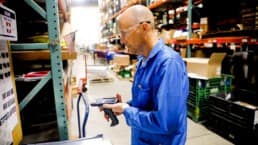
Assess Supply Chain Health:
You’ll also want to conduct a health assessment for your supply chain. To gauge this, companies must evaluate both raw materials, end products, and every step in between. This includes procurement, production, assembly, warehousing, packaging and delivery.
OEMs must consider their supply chain holistically and not just piecemeal. Without doing this, they run the risk of creating benefits for one segment of the supply chain that could prove detrimental to another.
Companies can start by mapping each manufacturing line from raw materials to the end-consumer. The purpose is to understand better your existing process, including its strengths and pain points.
You’ll also want to identify “value” during this step. It is nearly impossible to streamline a supply chain if the value points are not clearly understood. It is also important to take the time to talk with the various business lines. They’ll be able to tell you what steps are sticking points and what improvements they would like to see.
Monitor Key Performance Metrics:
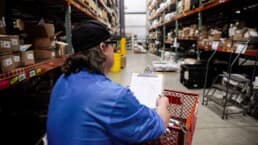
Companies must track and measure the performance of their supply chain. Doing this will identify the weak links and areas for improvement. With this data, you will be able to determine the health of your existing supply chain.
This isn’t just a one-time check though. You’ll want to continue to assess performance on a regular basis even after you’ve made your initial improvements. This will allow you to quantify the time and money saved by the efficiency steps. It will also guide supply chain improvements you consider in the future.
Identify Areas of Opportunity:
When looking for areas of opportunity, you’ll want to use the health assessment results from earlier. They will identify areas of opportunity across the supply chain. For example, many manufacturers have employed the concept of lean manufacturing for years. It focuses on streamlining operations to improve value and productivity while minimizing waste.
Thus, when identifying areas of opportunity within your supply chain, look for areas of potential waste. Make a list of opportunity areas and prioritize the issues you wish to focus on. You’ll need to consider their value and importance to the business and how easy they will be to resolve.
Consider a Contract Manufacturer:
Many OEMs will choose to outsource their supply chain operations to a contract manufacturer, like RIS. This enables OEMs to tap into the expertise of the partner organization and offers many benefits. Some of these benefits include increased flexibility, improved quality, time & cost savings and simplified purchasing and inventory management. This approach to manufacturing has been around for decades, and many industries rely heavily on outsourcing to remain competitive.
Companies should take the time to research and get to know each potential contract manufacturers. You’ll want to evaluate their history, the breadth of solutions offered and their quality program.
Reduce the Number of Providers:
OEMs typically have multiple vendors involved in their supply chain. But if you have too many vendors, this can lead to inefficiencies. Generally speaking, minimizing the number of providers along the supply chain is advantageous. When partnering with a single-source contract manufacturer, like RIS, businesses receive a complete manufacturing solution.
Reducing the number of providers adds value in a number of ways. It improves communications and accelerates the speed-to-market and cuts manufacturing and post-operations costs among other things.

Welcome Technology:
When optimizing your supply chain, technology is often your friend. You’ll want to research the latest and greatest in technology to see how it can benefit your operations.
Which of the pain points along your supply chain would benefit from new or enhanced technology? Selecting the right technology can result in a more streamlined and efficient supply chain.
Incorporate Secondary Operations:
Many companies with efficient supply chains have combined manufacturing with secondary, post-operation steps like assembly and product testing. Outsourcing secondary operations to a contract manufacturer saves time and money in multiple ways. Products will not have to be transported or stored between production and post-production steps. Contract manufacturers often secure better contract rates as they buy in bulk.
In addition to building and testing your products, the team at RIS performs fulfillment and distribution and warehousing services for a complete manufacturing solution.
Work Collaboratively:
After you’ve select a contract manufacturer to outsource part or all of your supply chain, there’s still work to be done. You will need to work collaboratively with your partner to achieve your desired objectives. After all, you are not simply looking for a contract manufacturer. You are looking for a trusted partner that can help your business grow.
Good communication and a spirit of collaboration are necessary for any customer-supplier relationship to thrive. A good outsourcing partner asks for input and listens to their customers. This way they can offer solutions that ensure both parties are aligned and satisfied.
About RiverSide Integrated Solutions
RIS is an advanced contract manufacturer providing robust solutions in circuit board assembly and product assembly. We employ more than 350 people and provide services to OEMs worldwide. We operate two state-of-the-art manufacturing facilities within the US.
With all of the choices in contract manufacturers out there, we know it can be challenging to find someone who understands your business model and has your best intentions in mind. RIS has always proven to be a win-win-focused relationship.
As your one-stop shop, we have the capabilities, capacity, quality assurance standards and resources to support all of your manufacturing needs. We understand that supply chain management is complex and very time-consuming, so we urge our customers to utilize us in the fullest capacity.
Our total-package solutions include:
- Extensive supply-chain network
- Full box-build assembly
- Dedicated Program Team
- Warehousing, kitting and drop-shipping capabilities
- Reverse logistics
- Flexible order fulfillment
- Scalability to meet your needs
Contact us today at (507) 523-3220 to see how we can help with your manufacturing project, or click contact us for a quote.
Contact us today at (507) 523-3220 to see how we can help with your PCB assembly needs, or click here for a quote.
The Latest PCB Innovations and Trends
The printed circuit board (PCB) industry is one of the fastest-growing sectors today. Experts forecast its worth will be nearly $76 billion by 2025. What’s more, PCB technologies have advanced significantly over the last decade. These advancements have been largely fueled by the rapid growth of the industry and the demand for more functionality. And so far, it shows no signs of slowing down. One of the most notable and transformative innovations in the electronics sector is the Internet of Things (IoT). The IoT is the use of the internet in physical devices and everyday objects. As the name implies, these devices have internet connectivity. They also have other necessary hardware, like sensors or processors, that measure and report data in real-time. IoT is a broad concept, as the “thing” can refer to a wide range of objects. They range from a vehicle with sensors to an animal with a transponder. Other examples of connected devices include: IoT technologies are present in nearly every aspect of our lives. And the demand for connected devices, especially wearables and hand-helds, is only expected to grow. As a result, companies across nearly every industry use connected devices to operate more efficiently. These devices access real-time data to enhance decision-making and add value to the business. Connected technologies are everywhere. From smart factories with automated manufacturing to construction with hand-held devices and aircraft with smart sensors. And at the heart of each device is a PCB. The IoT and connected devices continue to spread rapidly as the demand grows for these electronics. Industries realize that nearly every device needs to be smart in the digital era. As a result, original equipment manufacturers (OEMs) are pushing to provide designs that deliver higher performance and advanced functionality. As new trends emerge, PCB processes must all adapt to the advancements of today’s and tomorrow’s electronics industry. Given how rapidly the electronics industry has evolved in recent years, there are several key PCB innovations to watch. Below are some of the latest PCB innovations and trends. It should be noted that PCB assembly (PCBA) is becoming more complex over time. Pressure continues to increase to deliver high-quality PCBs at faster turnaround times. This has pushed many OEMs to outsource their PCBA, hoping to save time and money. Instead, they partner with a contract manufacturer specializing in their manufacturing area. When selecting a partner, OEMs must team up with professionals, like RiverSide Integrated Solutions (RIS), that employ advanced technologies. At RIS, we focus on meeting the challenges of new PCB innovations and keeping up with the ever-evolving trends. PCB technologies now enable the production of high-power PCBs that can manage voltage at 48V and above. Because of this advancement, a broader range of electronics can use higher power boards. These boards can also accommodate more components, increasing their functionality beyond the typical PCB design. The trend for more high-power PCBs continues to grow. This is especially true as the demand for electric vehicles and other applications expands. The need for smaller, lighter and thinner PCBs continues as demand accelerates for more portable and higher functionality electronics. This includes hand-held and wearable IoT devices for consumer and commercial markets. High-density circuitry is an amazing advancement that has enabled the tinier, more tightly packed boards necessary for these devices. These high-density boards also reduce the need for layering, often resulting in lower production costs. For these reasons, high-density PCBs are gaining popularity in smart devices. Additionally, consumers expect connected devices to deliver long battery life, requiring PCB designs to provide robust power management systems. OEMs and contract manufacturers must keep up with these rapid advancements. That means investing in technology that can manufacture and assemble smaller boards with more compact components. Traditional PCBs are rigid and inflexible. One of the recent trends is toward more flexible PCBs. These are categorized as flex. These boards bend more and can withstand more movement than traditional boards. They are also able to withstand harsher conditions than rigid PCBs. Flex PCBs are often more impact resistant, such as the impact of dropping a cell phone. A third category of PCBs is rigid-flex or semi-flex, a hybrid option that offers offers the best attributes of both technologies. Rigid-flex PCBs typically contain flexible layers attached to one or more rigid boards. In order to remain competitive, contract manufacturers must broaden their expertise and their associated assembly processes. As the demand for electronics continues to climb, so does the concern over electronics waste. To address this issue, many OEMs focus on more sustainable designs. This includes biodegradable PCBs or recycling and reusing metals used in PCB manufacturing. There are many benefits to pursuing more environmentally friendly operations. From waste reduction to efficiency gains, improved brand reputation and the ability to meet new regulations. All of these options provide OEMs a more competitive edge. OEMs rely more heavily on process automation technologies to deliver high-quality products rapidly to market. The additional automation provides productivity and speed benefits. It also reduces labor costs and the risk of error during operations. Finally, automation and robotics also allow for easier customization and modifications. Design changes can be made by simply modifying the software input. At RIS, PCB assembly is one of our core competencies. We provide reliable, seamlessly-assembled printed circuit board systems built with extreme precision. Our skilled engineers, technicians and assemblers work to expertly put together a complete PCBA. When you choose RIS, you can expect the hands-on customer care of a small operation with the capabilities characteristic of a larger company. We provide our complete electronics manufacturing services for OEMs in any industry. Our electronics assembly expertise includes:What is the Internet of Things?
PCB Trends in 2022 and Beyond
High-Power PCBs
MINIATURE PCBS
MORE FLEXIBLE PCBS
MORE SUSTAINABLE PCB DESIGNS
MORE RELIANCE ON AUTOMATION IN PCB MANUFACTURING
RIS PCBA EXPERTISE
About RiverSide Integrated Solutions
RIS is an advanced contract manufacturer providing robust solutions in circuit board assembly and product assembly. We employ more than 350 people and provide services to OEMs worldwide. We operate two state-of-the-art manufacturing facilities within the US.
With all of the choices in contract manufacturers out there, we know it can be challenging to find someone who understands your business model and has your best intentions in mind. RIS has always proven to be a win-win-focused relationship.
As your one-stop shop, we have the capabilities, capacity, quality assurance standards and resources to support all of your manufacturing needs. We understand that supply chain management is complex and very time-consuming, so we urge our customers to utilize us in the fullest capacity.
Our total-package solutions include:
- Extensive supply-chain network
- Full box-build assembly
- Dedicated Program Team
- Warehousing, kitting and drop-shipping capabilities
- Reverse logistics
- Flexible order fulfillment
- Scalability to meet your needs
Contact us today at (507) 523-3220 to see how we can help with your manufacturing project, or click contact us for a quote.
What to Look for in a Fulfillment and Distribution Partner
A company’s supply chain starts with raw material acquisition. It ends when the customer receives the final product. It also comprises all of the suppliers participating in the sourcing, manufacturing, kitting, assembly, warehousing, fulfillment and distribution processes. Companies are constantly under pressure to reduce costs while maintaining excellent quality. To achieve these objectives, manufacturers are turning to outsourcing to integrate along the supply chain strategically. This offers them broader control and reduces their risk level. This approach streamlines the entire supply chain, resulting in a more cost-effective solution. Strategic integration is when your contract manufacturer is responsible for additional supply chain stages. For example, a contract manufacturer broadens its solutions to include more pieces of the manufacturing and fulfillment process. They may offer assembly, kitting, fulfillment and distribution responsibilities instead of solely manufacturing products. The key concept is that integrated contract manufacturers control and are responsible for more steps in the supply chain. As noted below, there is tremendous value in partnering with a contract manufacturer, like Riverside Integrated Solutions (RIS). We offer integrated manufacturing solutions on top of our manufacturing and assembly. Our team also performs fulfillment & distribution and warehousing services for a complete manufacturing solution. Over time, manufacturing continues shifting towards an increasingly specialized environment, especially as technology evolves and develops. OEMs may ask, “Should I perform this portion of my supply chain in-house or outsource it?” To answer this question, original equipment manufacturers (OEMs) must decide what core competencies they wish to keep in-house. Outsourcing frees OEMs to focus on their core business competencies and strategic vision. These are often different than services such as fulfillment and distribution. For this reason, many companies outsource these responsibilities to their contract manufacturer. Additionally, OEMs are already outsourcing portions of their supply chain to multiple contract manufacturers. In that case, it is crucial to understand the value of reducing the number of suppliers they work with. Working with a single strategic partner, like RIS, can prove highly advantageous. Below are some key traits for your fulfillment and distribution partner. Watch our short video for more information about the fulfillment and distribution solutions at RIS. Fulfillment and distribution are great services to add to existing contract manufacturing responsibilities. One of the most significant benefits of RIS as your contract manufacturer is the complete start-to-finish support we provide. From procuring materials to building or kitting your product to the final outbound shipment, you gain access to our comprehensive distribution capabilities. We are your fulfillment and distribution partner with comprehensive expertise. We excel in everything from e-commerce, shipments direct to production facilities and distribution to dealer networks worldwide. RIS is truly a one-stop shop. Having your fulfillment and distribution partner in a central location poses many benefits. It provides easy access to key logistics channels and makes good business sense. At RIS, our centralized location means we can ship to either coast in just a few days. We then delivery this savings on to our customers. Our worldwide logistics solutions can accommodate your international orders anywhere they need to go. At RIS, we make shipping easy. There is no need to worry about shipping your product to us in consumer-ready packaging. We accept bulk-pallet shipments and re-pack as needed. This is a more efficient way for our customers to operate. Partnering with an integrated contract manufacturer makes for much simpler system integration. At RIS, we can set up our order processing systems to automatically download your orders and process them. You will see what orders have shipped, and your customer will receive tracking notifications. At RIS, robust inventory management is essential to a healthy supply chain. Our inventory management system will provide you with your current stock levels of products. These custom inventory reports are updated daily to provide real-time access to your stock. Consumers today can shop with their fingertips across multiple outlets – and often do so frequently. For this reason, your fulfillment and distribution partner must have eCommerce expertise. The professionals at RIS have proven experience with eCommerce, including major dot-com retailers like Amazon. We connect you with your customers, no matter where they are. As markets become increasingly competitive, integration becomes more of a necessity for manufacturers. By integrating additional steps, OEMs reap the benefits of lower risk, higher efficiency and lower costs. All of these things provide a critical competitive edge. Below are some areas where OEMs gain value from an integrated contract manufacturer, like RIS. Decreased expenses are one of the main advantages of integration. The cost benefits are typically lower labor, operating, equipment and overhead expenses. This is because in-house personnel and facilities are no longer needed to perform the given services. Working with a single strategic partner can also save costs through higher efficiency. Some OEMs also experience decreased inventory and warehousing costs due to a more optimized supply chain. Additionally, there may be raw material, logistics, storage and packaging savings when working with a contract manufacturer like RIS. We have well-established networks which enable us to procure, store and transport materials more quickly and economically than OEMs. Simply put, the fewer suppliers participating in the supply chain, the fewer hand-offs occur. This means fewer opportunities for disruptions and delays. Integrated contract manufacturers control more of the supply chain, have fewer surprises, and can more effectively manage any problems. Additionally, the supply chain process flows more smoothly for integrated manufacturers. This allows them to get products to customers more rapidly and reduce time to market. Partnering with a contract manufacturer with experience and expertise in these services often results in higher productivity and quality. OEMs can leverage the contract manufacturer’s established and vetted best practices, processes and expertise for the service. Working with RIS makes OEMs more nimble and responsive to market fluctuations and changing customer demands. Their distribution networks are in place to seamlessly move goods as necessary. Integration also provides an economy of scale is often not feasible for OEMs and non-integrated manufacturers. Instead of relying on multiple suppliers, integrated manufacturers can directly influence the customer experience throughout the supply chain. Also, integration allows manufacturers to track and control quality as the product progresses through the supply chain. This results in fewer quality and fulfillment issues and a better overall customer experience.WHY INTEGRATE FULFILLMENT AND DISTRIBUTION?
COMPLETE MANUFACTURING SOLUTIONS
CENTRAL LOCATION
OFFERS PICK, PACK AND SHIP
SIMPLE SYSTEM INTEGRATION
STRONG AND TIMELY INVENTORY MANAGEMENT
ECOMMERCE EXPERIENCE
THE VALUE OF INTEGRATED MANUFACTURING SOLUTIONS
LOWER COSTS
FEWER DISRUPTIONS AND FASTER SPEED TO MARKET
INCREASED EFFICIENCY AND QUALITY
MORE MANUFACTURING FLEXIBILITY
IMPROVED CUSTOMER SATISFACTION
About RiverSide Integrated Solutions
RIS is an advanced contract manufacturer providing robust solutions in circuit board assembly and product assembly. We employ more than 350 people and provide services to OEMs worldwide. We operate two state-of-the-art manufacturing facilities within the US.
With all of the choices in contract manufacturers out there, we know it can be challenging to find someone who understands your business model and has your best intentions in mind. RIS has always proven to be a win-win-focused relationship.
As your one-stop shop, we have the capabilities, capacity, quality assurance standards and resources to support all of your manufacturing needs. We understand that supply chain management is complex and very time-consuming, so we urge our customers to utilize us in the fullest capacity.
Our total-package solutions include:
- Extensive supply-chain network
- Full box-build assembly
- Dedicated Program Team
- Warehousing, kitting and drop-shipping capabilities
- Reverse logistics
- Flexible order fulfillment
- Scalability to meet your needs
Contact us today at (507) 523-3220 to see how we can help with your manufacturing project, or click contact us for a quote.

